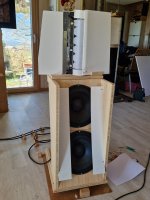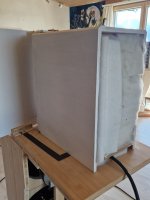Say you have a driver area of 100 with an Xmax of 2 = VD 200. (VD is volume displacement and Xmax is the max amount of movement from the voice coil)It's clear to me what you're writing. Larger rubanoids go deeper, but why?
With a driver area of 200 you got the same result with an Xmax of 1 that's also VD 200.
So bigger area result in a lower Xmax.
Lets say the rubanoide Xmax is fixed at 1 then you need to increase the driver area to go lower.
That's because it's the sum of Driver area times Xmax = VD
And to go lower you need more VD for the same amount of dB.
Rob
Okay, my question is not understood. Maybe it's because of google translate. I'll make a drawing soon for better understanding. Thanks for the replies
So again my question: Why does the ruba1 and 1/1 ruba (25cm) only run on 500 hz/ -3 db The ruba2 (50cm) on 300 Hz-3db ?
It's already in my answer.
Also the small ruba1 goes lower than 500Hz but they use this crossover to gain enough output with low distortion.
Rob
Also the small ruba1 goes lower than 500Hz but they use this crossover to gain enough output with low distortion.
Rob
Okay Rob, this has been described differently in this topic. Of course, a lot of things can be manipulated with a crossover. Thank you very much. My question about the copper cap has not yet been answered. It's not about using it or not, but does this copper cap have to be electrically insulated from the pole plate?
Also , ruba2 has a lower fs due to double diafram mass then the others, when same materials are used in both.So again my question: Why does the ruba1 and 1/1 ruba (25cm) only run on 500 hz/ -3 db The ruba2 (50cm) on 300 Hz-3db ?
Mass in relation to the strength of the drive. Weak drive equals lower fs. The diaphragm shape of the ruba, together with the single-sided drive, is a problem of little movement and little draft. Increasing the mass of the same membrane brings little. High frequencies also suffer from this. Fs the rubanoid is usually very deep.
Great entertainment seeing the video of construction.
But all kinds of things are unknown about the linearity, hysteresis, and so on of the gap and of that sheet of ordinary household plastic which supplies the restoring force.
A simple matter to test distortion and other parameters.
But all kinds of things are unknown about the linearity, hysteresis, and so on of the gap and of that sheet of ordinary household plastic which supplies the restoring force.
A simple matter to test distortion and other parameters.
Finally found the curves that contradict the answers given. Lengthening the membrane leads to more depth. If this had to do with x.max, then the curves would also have to be apart at 1000 Hz? But it could also be that I'm too stupid.
greetings

greetings
Wy?
I told before that larger membrane leeds to more dept.
you also have to deal with the dipole characteristic.
With a smaller size you will have at a higher frequency acoustic shorting.
Rob
I told before that larger membrane leeds to more dept.
you also have to deal with the dipole characteristic.
With a smaller size you will have at a higher frequency acoustic shorting.
Rob
Why is my name in there ? not even sure what i am looking at, what video was that. im sure it had to to with the black paper i used 🙂 but i think it had to do with top end extention. reason why... it has a small patern, making it more stiff in one direction only. and weaker in the other (not that i wanted, but thats what happens) its some sort of paper you can buiy at an art store. my favrourite place for anything rubanoide 🙂Finally found the curves that contradict the answers given. Lengthening the membrane leads to more depth. If this had to do with x.max, then the curves would also have to be apart at 1000 Hz? But it could also be that I'm too stupid.
greetingsView attachment 1294892
but what did i proof ? without knowing >?
Last edited:
now i have to see what videos i made and what they where about haha 🙂 it has been some time 🙂 let me dig.. but its gone be embarrassing in any case 🙂
Hello,
In a linear motor loudspeaker ((I don't use the word "rubanoid", which doesn't really describe the system), the coil can be modeled as a beam with a distributed load: the deformation in the middle of the system is a power of 4 of the length of the beam.
In a linear motor loudspeaker ((I don't use the word "rubanoid", which doesn't really describe the system), the coil can be modeled as a beam with a distributed load: the deformation in the middle of the system is a power of 4 of the length of the beam.
- Home
- Loudspeakers
- Planars & Exotics
- A DIY Ribbon Speaker of a different Kind

